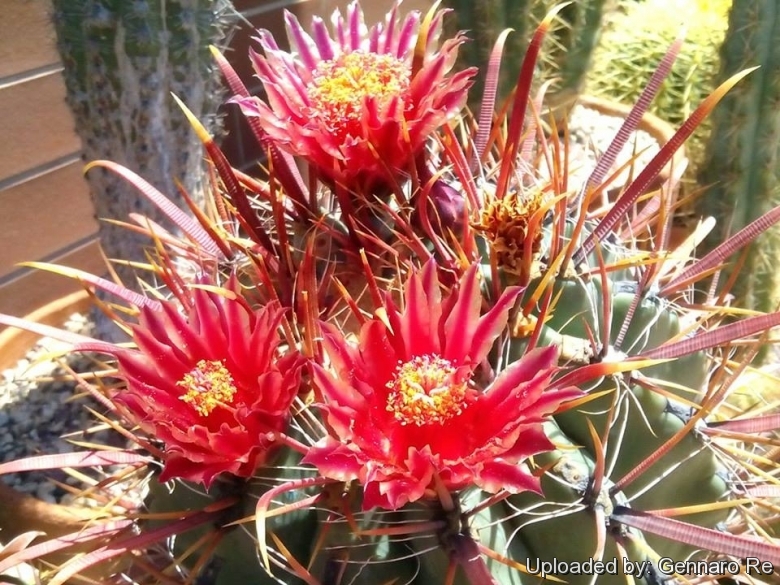
Ferocactus peninsulae Photo by: Gennaro Re
Origin and Habitat: Ferocactus peninsulaeSN|11977]]SN|11977]] is the common barrel cactus through the states of Baja California and Baja California Sur, North West Mexico(extent of occurrence over 50,000 km2)
Altitude: From sea level to 450 metres above sea level.
Habitat and Ecology: The species occurs in rocky places, in sandy areas and hillsides together with Mammillaria dioicaSN|916]]SN|916]], Cochemiea setispinaSN|9645]]SN|9645]], Echinocereus ferreirianusSN|21825]]SN|21825]] and Lophocereus schottiiSN|8344]]SN|8344]]. The species tends to be more common in the south than the north of the Baja peninsula, however, the population is declining. The main threat is illegal collection. It is also used as fodder for cattle, and there is habitat destruction due to urbanization and creation of artificial grasslands.
Synonyms:
See all synonyms of Ferocactus peninsulae
Common Names include:
LITHUANIAN (Lietuvių): Rausvasis ferokaktusas
SPANISH (Español): Visnaga, Bisnaga
SWEDISH (Svenska): Glöddjävulstunga
Description: Ferocactus peninsulaeSN|16130]]SN|11977]] is large ribbed barrel cactus with an erect stem becoming cylindric in age and attaining a height of 2,5 metres, which is unusual for the genus. Spines and flowers very similar to those of Ferocactus wislizeniSN|16130]]SN|16130]]. Cultivated plants can be reliably distinguished from Ferocactus wislizeniSN|11977]]SN|16130]] var. herrerae only when seeds or details of wild source are available.
Habit: Plants simple.
Stem: Unbranched, erect, up to 2,5 meters high (but usually about 70 cm), up to 40 across. Spherical, ovoid, clavate to cylindric to tapering toward the apex dark blue-green.
Ribs: 12 to 20, prominent, acute.
Areoles: Young areoles brown-felted, circular up to 20 mm long, constricted between the flower and the spine-bearing section, 4 cm apart or even less in old plants.
Central spines: 4, forming a cross, reddish with yellow tips, greyish or brown, the lower one flattened, strongly hooked, annulate.
Radial spines: 6-13 (usually more than 10) brownish or white, spreading, variable, straight, slender, terete, more or less annulate, the lower ones stouter and more colored, sometimes twisted and bristle-like.
Flowers: Broadly funnelform, 5-6 cm long red to yellow with orange to red midveins.
Blooming season: Spring to autumn.
Fruit: Globose, yellowish, 2,5-3,5 cm long, bearing broad rounded scales.
Seeds. Seeds 1,2-2 mm long, brown to black, noticeably reticulate. Ferocactus peninsulaeSN|16130]]SN|11977]] is large ribbed barrel cactus with an erect stem becoming cylindric in age and attaining a height of 2,5 metres, which is unusual for the genus. Spines and flowers very similar to those of Ferocactus wislizeniSN|16130]]SN|16130]]. Cultivated plants can be reliably distinguished from Ferocactus wislizeniSN|11977]]SN|16130]] var. herrerae only when seeds or details of wild source are available.
Habit: Plants simple.
Stem: Unbranched, erect, up to 2,5 meters high (but usually about 70 cm), up to 40 across. Spherical, ovoid, clavate to cylindric to tapering toward the apex dark blue-green.
Ribs: 12 to 20, prominent, acute.
Areoles: Young areoles brown-felted, circular up to 20 mm long, constricted between the flower and the spine-bearing section, 4 cm apart or even less in old plants.
Central spines: 4, forming a cross, reddish with yellow tips, greyish or brown, the lower one flattened, strongly hooked, annulate.
Radial spines: 6-13 (usually more than 10) brownish or white, spreading, variable, straight, slender, terete, more or less annulate, the lower ones stouter and more colored, sometimes twisted and bristle-like.
Flowers: Broadly funnelform, 5-6 cm long red to yellow with orange to red midveins.
Blooming season: Spring to autumn.
Fruit: Globose, yellowish, 2,5-3,5 cm long, bearing broad rounded scales.
Seeds: 1,2-2 mm long, brown to black, noticeably reticulate.
Subspecies, varieties, forms and cultivars of plants belonging to the Ferocactus peninsulae/wislizenii complex
This Taxon has various synonyms whit several controversial varieties and subspecies and comprises a multitude of different forms, but where each form is linked to others by populations of plants with intermediate characteristics:
 Ferocactus gracilis H.E.Gates: (subsp. gracilis) has stems up to 1 m in tall and has central spines less than 5 mm wide.Distribution: northern central Baja California.
Ferocactus gracilis H.E.Gates: (subsp. gracilis) has stems up to 1 m in tall and has central spines less than 5 mm wide.Distribution: northern central Baja California. Ferocactus gracilis subs. coloratus (H.E.Gates) N.P.Taylor: Usually less than 1 m tall but the widest central spines often exceed 5 mm. Distribution: south of subspecies gracilis.
Ferocactus gracilis subs. coloratus (H.E.Gates) N.P.Taylor: Usually less than 1 m tall but the widest central spines often exceed 5 mm. Distribution: south of subspecies gracilis. Ferocactus gracilis subs. gatesii (G.E.Linds.) N.P.Taylor: Up to 1,5 m tall, and the central spines are curved but not hooked and only 3 mm wide. Distribution: Bahia de los Angeles in the gulf of California (Smith Islands group in the Sea of Cortez)
Ferocactus gracilis subs. gatesii (G.E.Linds.) N.P.Taylor: Up to 1,5 m tall, and the central spines are curved but not hooked and only 3 mm wide. Distribution: Bahia de los Angeles in the gulf of California (Smith Islands group in the Sea of Cortez)- Ferocactus horridus Britton & Rose
 Ferocactus peninsulae (F.A.C.Weber) Britton & Rose: (subsp. peninsulae) has 4 central spines, forming a cross. Principal central spine flattened and strongly hooked, flowers over 5 cm long, outer periant segments spatulate. Plant somewhat allways taller than broad. Distribution: Baja California.
Ferocactus peninsulae (F.A.C.Weber) Britton & Rose: (subsp. peninsulae) has 4 central spines, forming a cross. Principal central spine flattened and strongly hooked, flowers over 5 cm long, outer periant segments spatulate. Plant somewhat allways taller than broad. Distribution: Baja California. Ferocactus peninsulae f. brevispinus (Chinned type): has very odd chinned ribs.
Ferocactus peninsulae f. brevispinus (Chinned type): has very odd chinned ribs. Ferocactus peninsulae f. brevispinus cristatus hort.: Crested form.
Ferocactus peninsulae f. brevispinus cristatus hort.: Crested form. Ferocactus peninsulae f. brevispinus hort.: short spined form.
Ferocactus peninsulae f. brevispinus hort.: short spined form. Ferocactus peninsulae f. brevispinus cv. Artichoke: spineless form remembering in shape an Obregonia denegrii.
Ferocactus peninsulae f. brevispinus cv. Artichoke: spineless form remembering in shape an Obregonia denegrii. Ferocactus peninsulae subs. santa-maria (Britton & Rose) Pilbeam & Bowdery: has yellow flowers, principal central spine straight or slightly curved. Plant somewhat conical, taller than broad. Distribution: Southern Baja California.
Ferocactus peninsulae subs. santa-maria (Britton & Rose) Pilbeam & Bowdery: has yellow flowers, principal central spine straight or slightly curved. Plant somewhat conical, taller than broad. Distribution: Southern Baja California. Ferocactus peninsulae subs. townsendianus (Britton & Rose) Pilbeam & Bowdery: has orange or red flowers, principal central spine strongly hooked. Plant somewhat conical, taller than broad. Distribution: Baja California (Magdalena Plain, Santa Margarita, Magdalena Islands).
Ferocactus peninsulae subs. townsendianus (Britton & Rose) Pilbeam & Bowdery: has orange or red flowers, principal central spine strongly hooked. Plant somewhat conical, taller than broad. Distribution: Baja California (Magdalena Plain, Santa Margarita, Magdalena Islands). Ferocactus peninsulae subs. viscainensis (H.E.Gates) F.Wolf & R.Wolf: has 4 central spines, forming a cross. Plant to 1,5 m tall and 3 dm wide. Ribs 13-21. Distribution: Baja california norte.
Ferocactus peninsulae subs. viscainensis (H.E.Gates) F.Wolf & R.Wolf: has 4 central spines, forming a cross. Plant to 1,5 m tall and 3 dm wide. Ribs 13-21. Distribution: Baja california norte.
Bibliography: Major references and further lectures
1) James Cullen, Sabina G. Knees, H. Suzanne Cubey “The European Garden Flora Flowering Plants: A Manual for the Identification of Plants Cultivated in Europe, Both Out-of-Doors and Under Glass” Cambridge University Press, 11/Aug./2011
2) David Hunt, Nigel Taylor “The New Cactus Lexicon” DH Books, 2006
3) Edward F. Anderson “The Cactus Family” Timber Press, 2001
4) Nathaniel Lord Britton, Joseph Nelson Rose “Cactaceae: Descriptions and Illustrations of Plants of the Cactus Family” Volume 3, 1922
5) Jeanette Coyle, Norman C. Roberts “A field guide to the common and interesting plants of Baja California” Natural History Pub. Co., 1975
6) León de la Luz, J.L., Hernández, H.M. & Gómez-Hinostrosa, C. 2013. Ferocactus peninsulae. In: IUCN 2013. "IUCN Red List of Threatened Species." Version 2013.2. <www.iucnredlist.org>. Downloaded on 06 March 2014.
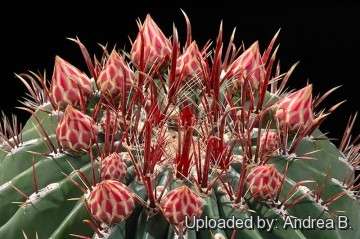 Ferocactus peninsulae Photo by: Andrea B.
Ferocactus peninsulae Photo by: Andrea B.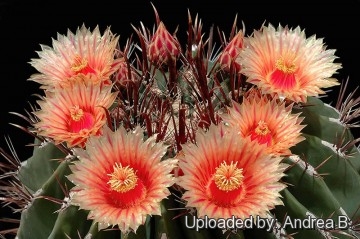 Ferocactus peninsulae Photo by: Andrea B.
Ferocactus peninsulae Photo by: Andrea B.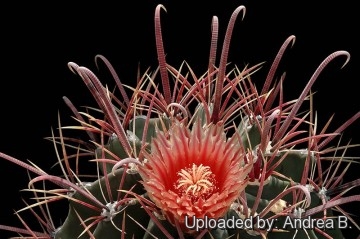 Ferocactus peninsulae Photo by: Andrea B.
Ferocactus peninsulae Photo by: Andrea B.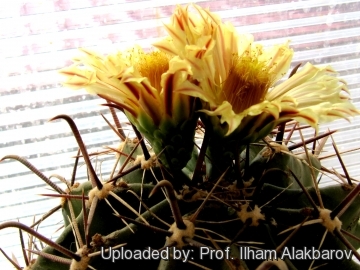 Ferocactus peninsulae Photo by: Prof. Ilham Alakbarov
Ferocactus peninsulae Photo by: Prof. Ilham Alakbarov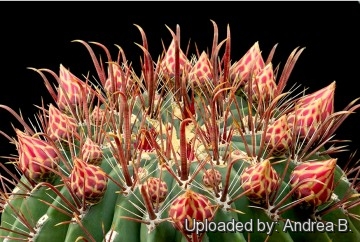 Ferocactus peninsulae Photo by: Andrea B.
Ferocactus peninsulae Photo by: Andrea B.Send a photo of this plant.The gallery now contains thousands of pictures, however it is possible to do even more. We are, of course, seeking photos of species not yet shown in the gallery but not only that, we are also looking for better pictures than those already present.
Read More... Cultivation and Propagation: Ferocactus peninsulaeSN|11977]]SN|11977]] is a summer-growing and pretty easy plant thought slow to start. It makes great potted specimens, and is a great cactus for beginning collectors.
Growth rate: It is a slow growing species. Plant in good conditions will start to bloom when reach the diameter of only 20-25 cm.
Soil: It grows well in a rich, well drained soil such us clay, pumice, lava grit, and only a little peat or leaf-mould, but it isn't picky about soil.
Repotting: If potted, repot them preferably in the spring, if their roots become cramped. Generally, they should be repotted every other year in order to provide fresh soil. However, this doesn't necessarily mean they'll need larger containers. Fill about a quarter of the pot with broken crocks, gravel, etc. to promote good drainage. After repotting, do not water for a week or more. Use pot with good drainage. Eventually, as the plant becomes mature grow it slowly, and adopt a new repotting period, using intervals of every 2 - 3 years. Additionally grow it under drier conditions or with stronger sunlight.
Watering: Water regularly during the summer so long as the plant pot is allowed to drain and not sit in a tray of water (It rots easily, especially if over wet), and also needs to be avoided wetting the body of this plant while it is in sunlight. A wet cactus in the sun light can cause sun burning which can lead to scares or even fungal infections and death.. Let dry between watering. During hot weather you may need to water the plants more frequently so long as the plant is actively growing. From late September watering should be reduced to force the plant to go in to a state of semi dormancy, by October you should be back in to the winter watering regime. If the soil is allowed to be dry for too long root loss could follow but equally the same result would occur if the plants are both wet and cold. From March onward the plant will begin to grow and watering should be increased gradually until late May when the plant should be in full growth
Fertilization: Feed with a high potassium fertilizer in summer. Feeding may not be necessary at all if the compost is fresh then, feed in summer only if the plant hasn't been repotted recently. Do not feed the plants from September onward as this can cause lush growth which can be fatal during the darker cold months.
Hardiness: When dormant, the plant is slightly cold tolerant (down to nearly -2° C or less), but when left out it is more sensitive to frost. However warmth throughout the year will increase the grower's success (at minimum temperatures above 5 degrees centigrade during rest season). During the summer it is best to keep the plants outside where the temperature can rise to over 30 C with no harm to the plant. This plants need a period of cool rest in winter to produce flowers abundantly.
Exposure: They do need a lot of light to develop their typical spination, but different clones vary in their tolerance of full sunshine. However some protection in light shade is recommended during the hottest hours in summer. It can tolerate moderate shade, and a plant that has been growing in shade should be slowly hardened off before placing it in full sun as the plant will be severely scorched if moved too suddenly from shade into sun. If kept too dark they may become overly lush and greener and could be prone to rotting due to over watering.
Uses: It is an excellent plant for container growing. It always looks good and stays small. It looks fine in a cold greenhouse and frame.
Traditional uses: Mexicans on the peninsula of Lower California often cut off the spines of this plant and use it as feed for cattle.
Diseases and pests: Watch for infestations of mealybugs, scale insects and spider mite. Rot is only a minor problem with cacti if the plants are watered and “aired” correctly. If they are not, fungicides won't help all that much.
Propagation: Seeds are the only way of reproducing, remembering that seedlings dislike strong light and dry conditions and need to be repotted frequently. Seed Collecting: Permit fruit to ripen. Fruit must be significantly overripe before harvesting seed; clean and dry seeds.
















